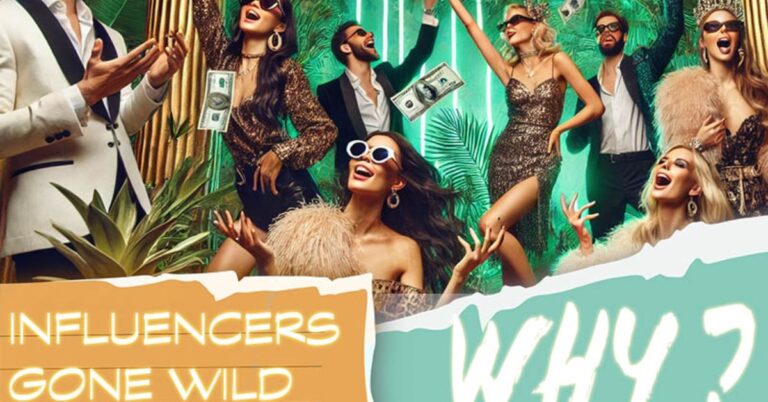In the digital age, the term “influencer” has become synonymous with individuals who wield significant power over audience perceptions and trends. Among the myriad of platforms and movements, “InfluencersGoneWild” has emerged as a captivating trend that captivates audiences worldwide. This phenomenon highlights the bold and unapologetic side of influencers who push boundaries, challenge norms, and redefine the digital landscape. As this trend continues to gain traction, it becomes essential to explore the intricacies of Influencers Gone Wild and understand its impact on both influencers and their followers.
What is “Influencers Gone Wild”?
The phrase “Influencers Gone Wild” encapsulates a movement where influencers choose to break away from the constraints of traditional content creation. It is a trend that celebrates authenticity, spontaneity, and unfiltered moments, allowing influencers to connect with their audiences more intimately. By sharing raw and unedited content, Influencers Gone Wild offers a refreshing departure from the polished personas often portrayed online. This trend resonates with audiences seeking genuine connections and experiences that go beyond traditional marketing and branding strategies.
The Rise of Influencers in Social Media
Social media influencers have transformed how brands communicate with consumers. Their authentic connections with followers make them effective marketers, contrasting traditional advertising methods. Influencers come in various tiers: macro (over 100,000 followers), micro (1,000 to 100,000 followers), and nano (less than 1,000 followers), each impacting trends and consumer behavior differently. Platforms like Instagram, TikTok, and YouTube have become pivotal in shaping public opinion and culture through influencer content.

The Allure and Risks of Going Wild
The allure of Influencers Gone Wild lies in its ability to break the mold and offer a refreshing departure from the polished personas often portrayed online. As more influencers embrace this trend, they embark on a journey of self-expression and creativity that captivates their followers. This exploration of raw, unedited content offers a unique window into the lives of influencers, fostering a sense of intimacy and relatability.
However, this unfiltered approach carries risks:
Promoting Harmful Trends: Some influencers may inadvertently endorse dangerous behaviors or misinformation.
False Advertising: Misleading endorsements can erode consumer trust.
Lack of Accountability: Unregulated content can lead to ethical concerns.
Psychological Impact: Both influencers and followers may experience mental health challenges due to the pressures of constant engagement.
Notable Examples of Influencers Gone Wild
Several instances highlight the phenomenon:
Logan Paul: Faced backlash for a controversial video in Japan’s Aokigahara Forest.
Fyre Festival: Promoted by influencers, leading to a disastrous event and legal consequences.
Jake Paul: Known for reckless behavior and controversial stunts.
Beauty Community Drama: Public feuds among beauty influencers affecting their reputations.
The Business of Influencers Gone Wild
Influencers leverage their viral moments for monetization through:
Sponsored Posts: Collaborations with brands for product promotions.
Merchandise Sales: Selling branded products to followers.
Exclusive Content: Offering premium content through subscriptions.
Brands benefit from the influencers’ reach but must navigate potential controversies that may arise from unfiltered content.

Psychological Motivations Behind the Trend
The drive for attention and validation can lead influencers to adopt extreme behaviors:
Attention-Seeking: Desire for visibility may result in risky content.
Fear of Missing Out (FOMO): Influencers may engage in trends to stay relevant.
Social Media Pressure: The need to maintain engagement can impact mental health.
Impact on Followers and Society
Influencers Gone Wild affects audiences by:
Shaping Social Norms: Influencers’ actions influence cultural perceptions.
Consumer Behavior: Endorsements can sway purchasing decisions.
Mental Health: Exposure to idealized lifestyles may affect self-esteem.
The trend prompts discussions on authenticity, responsibility, and the role of influencers in society.
Navigating the Future of Influencer Culture
To foster a healthier digital environment:
Promote Transparency: Clear disclosures of sponsored content.
Encourage Authenticity: Support genuine content over sensationalism.
Implement Regulations: Establish guidelines to hold influencers accountable.
Provide Support: Offer mental health resources for influencers and audiences.
By addressing these aspects, the influencer landscape can evolve into a more responsible and positive space.
Conclusion
“Influencers Gone Wild” reflects the evolving dynamics of social media, where authenticity and sensationalism intersect. While the trend offers a glimpse into the unfiltered lives of influencers, it also raises concerns about ethics, mental health, and societal impact. As the digital world continues to grow, fostering a culture of responsibility and support becomes imperative for influencers and their audiences alike.

